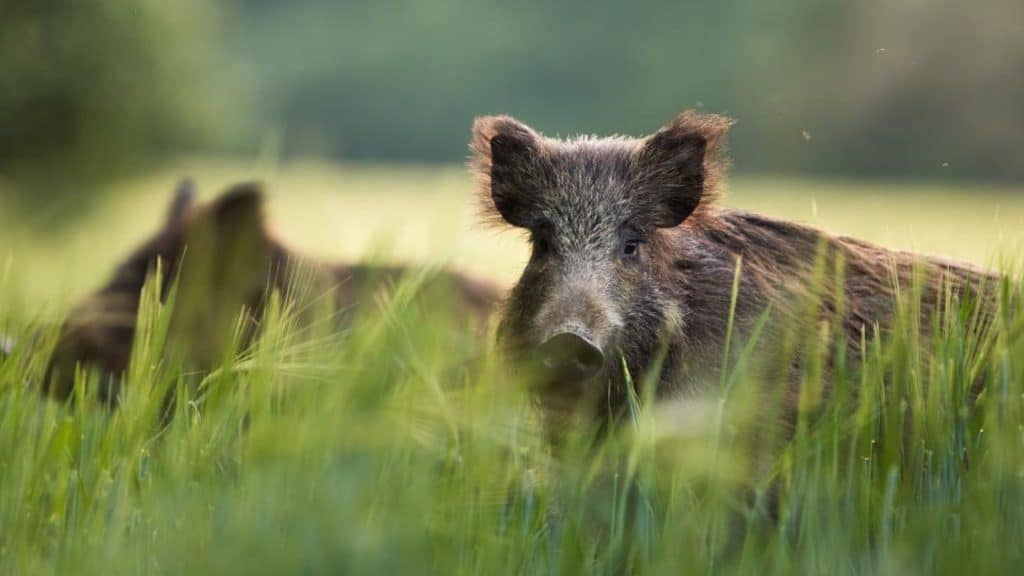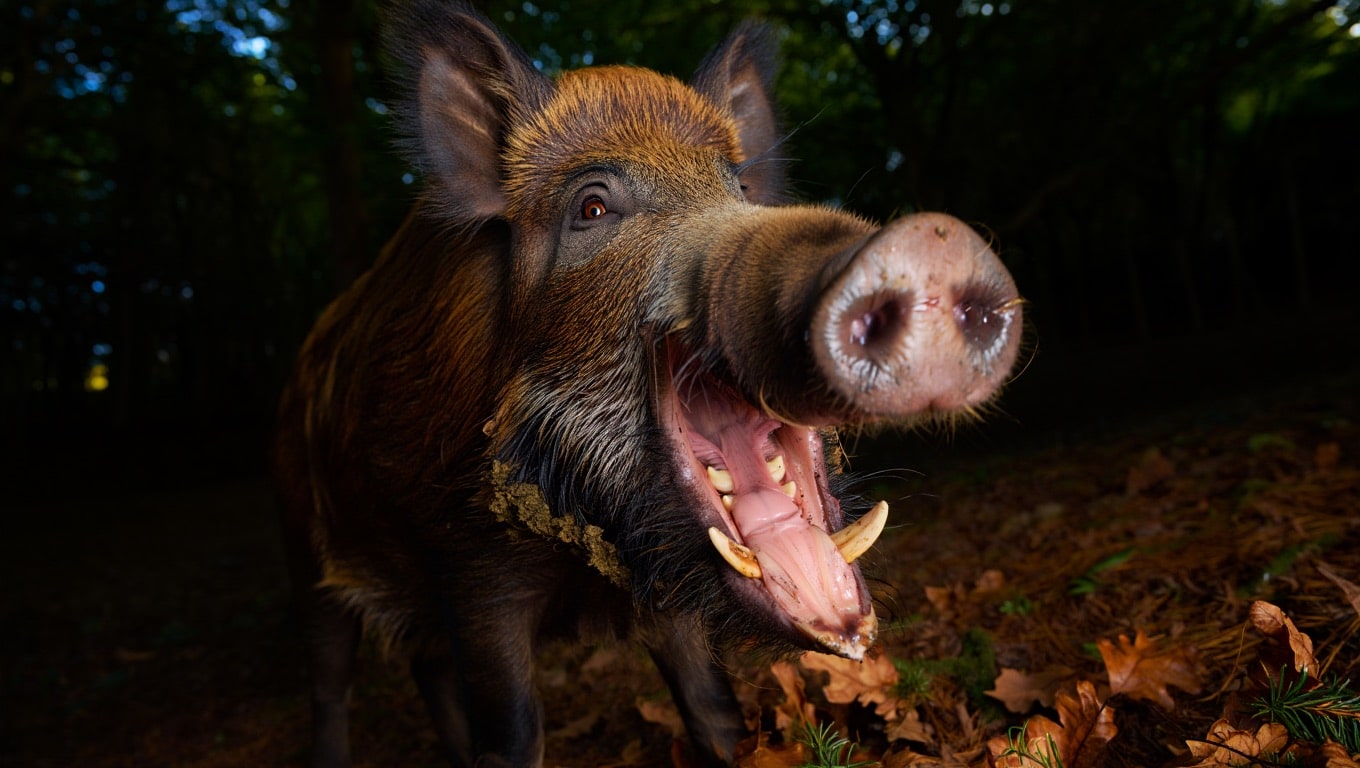Recently, wild boars have been increasingly seen near farms, towns, and even public parks. As their presence grows, so do safety concerns.
They are fast and strong and can act without warning, particularly when surprised or provoked.
Many people aren’t sure what to do when they spot one; should they back away, stand still, or be worried at all?
In this blog, we have explained when wild boars are most likely to become aggressive, what makes them dangerous, and how you can avoid risky encounters.
What are Wild Boars, and Why are People Concerned?
Wild boars are the wild ancestors of domestic pigs. They are heavier, more muscular, and far more aggressive.
Males have sharp tusks and can weigh over 200 pounds. Females, called sows, are very protective of their young.
These animals are found in forests, grasslands, and farmlands across Europe, Asia, Africa, Oceania, and parts of North and South America.
In recent years, they have moved closer to places where people live and work, leading to more encounters with humans, pets, and livestock.
Are Boars Dangerous to Humans?
Boar attacks are uncommon, but when they happen, the injuries can be serious. The tusks of a male can cut through flesh, and their speed and weight make them hard to stop if they charge.
Incidents have occurred involving hikers, farmers, and even people in suburban areas.
Most injuries affect the lower body, though some attacks have resulted in falls or bites.
What Makes Boars a Threat?
| Trait | Why It Matters |
|---|---|
| Tusks | Sharp and strong enough to cause deep wounds |
| Size and Strength | Adult males can reach 200–300 lbs and break through fences or barriers |
| Speed | Can run up to 30 mph in short bursts |
| Aggression | More territorial during mating season; females defend piglets without warning |
| Stealth | Blend into vegetation; may charge without being seen first |
| Disease Carrier | Can transmit illnesses to people, pets, and livestock |
When are Boars Most Dangerous?
Boars don’t look for conflict, but some situations make them more likely to attack:
- Breeding Season (Late Fall to Winter): Male boars become more territorial and unpredictable. They may see you as a rival if approached too closely.
- When Piglets Are Nearby: Sows will defend their young quickly and without warning. Even if piglets appear alone, the mother is usually close.
- Night or Early Morning: Boars are most active when it’s dark. Limited visibility increases the likelihood of accidental encounters and makes them more hazardous.
- If the Animal Is Hurt or Trapped: An injured or cornered boar may react violently. Survival mode kicks in, even if you’re trying to help.
- When Surrounded by Dogs or People: Boars may charge to escape if they feel trapped. Off-leash dogs often provoke boars, increasing the risk for both the pet and the owner.
Wild Boar vs. Domestic Pig: Key Differences
| Feature | Wild Boar | Domestic Pig |
|---|---|---|
| Origin | Wild ancestor of pigs | Bred for farming and food |
| Appearance | Dark fur, lean body, long snout | Pink or spotted, rounder body |
| Tusks | Prominent, sharp, and grow continuously | Often trimmed or absent |
| Behavior | Wary, aggressive when provoked | Docile and social |
| Speed | Up to 30 mph | Slower, less agile |
| Danger Level | High if surprised or threatened | Very low |
How to Avoid Boar Attacks?
It’s easier to prevent an encounter than deal with one. Follow these tips when outdoors in areas where boars are known to live:
- Stay alert in wooded or brushy areas
- Avoid walking alone at night in rural or forested places
- Stick to trails when hiking or biking
- Make noise while walking to avoid surprising animals
- Never approach piglets, even if they seem alone
- Don’t feed boars, they will return looking for more
- Please keep dogs on a leash, pets may provoke a boar and bring it closer to you
What to Do If You Encounter a Wild Boar?
Seeing a boar doesn’t always lead to danger; how you react matters most.
If you spot a boar nearby,
- Stay calm
- Don’t run, it may trigger a chase
- Slowly back away while facing the animal
- Give it space to escape
- Speak softly or clap to let it know you’re there (if it hasn’t noticed you yet)
If a boar charges at you,
- Try to get behind a tree or a large object
- Use a stick or a backpack to block tusks if needed
- Protect your head and neck if knocked down
- Seek help right after the incident, even for small wounds
- Report the attack to local wildlife authorities
Staying calm and reacting wisely can make all the difference. Most boar encounters end safely when you give them space and avoid sudden moves.
Diseases Wild Boars Can Spread
| Disease | How It’s Spread | Risk |
|---|---|---|
| Brucellosis | Contact with fluids or undercooked meat | Fever, muscle pain, fatigue |
| Leptospirosis | Through water contaminated with urine | Flu-like symptoms can affect the kidneys |
| Swine Flu (H1N1) | From pigs to humans (rare) | Respiratory illness |
| Pseudorabies | Dangerous to livestock, not people | Fatal in pigs, dogs, and cats |
Avoid touching dead boars or open wounds. Use gloves when handling meat, and cook it thoroughly.
Note: While disease transmission is not an immediate physical threat like an attack, it is still an important safety concern associated with wild boar presence.
Summary
Wild boars can be dangerous, but only in certain situations. They don’t naturally look for fights with humans.
Most attacks happen when boars feel trapped or are protecting their babies. Male boars get more aggressive during mating season.
Their speed, sharp tusks, and strength make them concerning. However, you can easily avoid danger by staying calm and giving them space.
Never run away or try to provoke them. So, if you see a wild boar, back away slowly and leave it alone.






















